SAAB 9-7X 2006 Owners Manual
Manufacturer: SAAB, Model Year: 2006, Model line: 9-7X, Model: SAAB 9-7X 2006Pages: 434, PDF Size: 2.89 MB
Page 331 of 434

Headlamp Aiming
Headlamp aim has been preset at the factory and
should need no further adjustment.
If your vehicle is damaged in an accident, the headlamp
aim may be affected. Aim adjustment to the low-beam
headlamps may be necessary if it is difficult to see the
lane markers (for horizontal aim), or if oncoming drivers
�ash their high-beam headlamps at you (for vertical aim).
If you believe your headlamps need to be re-aimed, we
recommend that you take your vehicle to your dealer for
service.
Bulb Replacement
For the proper type of replacement bulbs, see
Replacement Bulbs on page 5-53.
For any bulb changing procedure not listed in this
section, contact your dealer.
High Intensity Discharge (HID)
Lighting
{CAUTION:
The low beam high intensity discharge lighting
system operates at a very high voltage. If you
try to service any of the system components,
you could be seriously injured. Have your
dealer or a quali�ed technician service them.
Your vehicle may have HID headlamps. After your
vehicle’s HID headlamp bulb has been replaced, you
may notice that the beam is a slightly different shade
than it was originally. This is normal.
5-49
ProCarManuals.com
Page 332 of 434

Halogen Bulbs
{CAUTION:
Halogen bulbs have pressurized gas inside and
can burst if you drop or scratch the bulb. You or
others could be injured. Be sure to read and
follow the instructions on the bulb package.
Headlamps, Front Turn Signal,
Sidemarker, and Parking Lamps
Halogen Bulb Replacement
A. High-Beam
Headlamp
B. Low-Beam
HeadlampC. Parking/Turn
Signal
D. Sidemarker
5-50
ProCarManuals.com
Page 333 of 434

To replace one of these bulbs, do the following:
1. Open the hood. SeeHood Release on page 5-11
for more information.
2. Lift the two headlamp retaining clips to release the
headlamp assembly from the vehicle.
3. Pull the headlamp assembly away from the vehicle.
4. Remove the circular bulb cover for the high and
low-beam bulbs.5. Turn the bulb socket counterclockwise to remove it
from the headlamp assembly.
6. Pull the old bulb straight out of the bulb socket.
7. Install a new bulb and turn it clockwise to secure.
8. Reinstall the circular bulb covers, if necessary.
9. Reinstall the headlamp assembly by lining up the
headlamp assembly with the slots in the headlamp
retaining clips
10. Press down on the headlamp retaining clips to
secure the headlamp assembly.
HID Low-Beam Bulb Replacement
If your vehicle has HID low-beam headlamps and a bulb
needs to be replaced, see your dealer for replacement.
5-51
ProCarManuals.com
Page 334 of 434
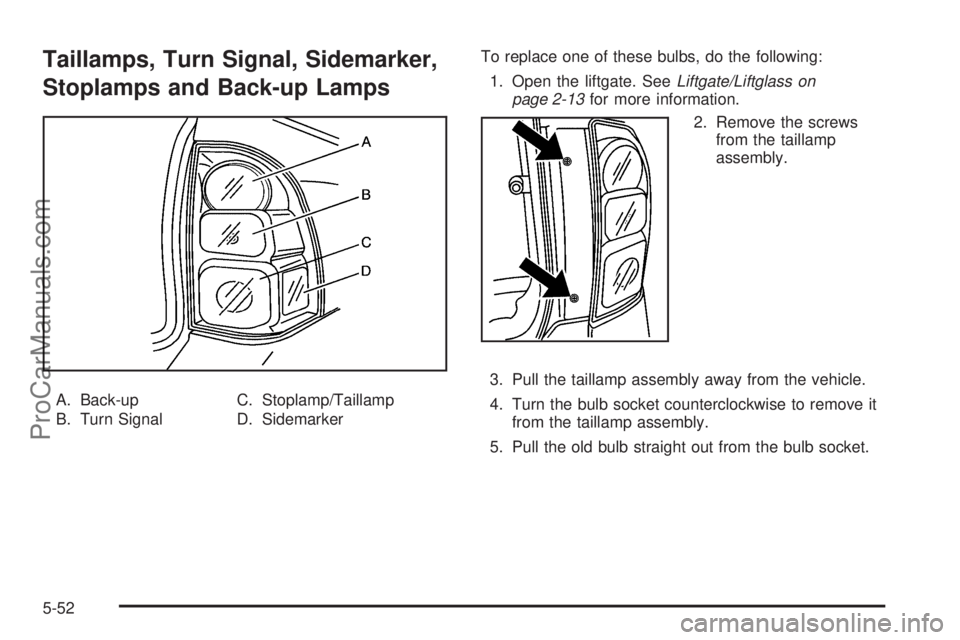
Taillamps, Turn Signal, Sidemarker,
Stoplamps and Back-up Lamps
A. Back-up
B. Turn SignalC. Stoplamp/Taillamp
D. SidemarkerTo replace one of these bulbs, do the following:
1. Open the liftgate. SeeLiftgate/Liftglass on
page 2-13for more information.
2. Remove the screws
from the taillamp
assembly.
3. Pull the taillamp assembly away from the vehicle.
4. Turn the bulb socket counterclockwise to remove it
from the taillamp assembly.
5. Pull the old bulb straight out from the bulb socket.
5-52
ProCarManuals.com
Page 335 of 434

6. Press a new bulb into the bulb socket.
7. Insert the bulb socket into the taillamp assembly
and turn it clockwise to secure.
8. Reinstall the taillamp assembly into the vehicle and
tighten the two screws.
Replacement Bulbs
Exterior Lamp Bulb Number
Back-Up Lamp 921
Front Parking, Turn Signal Lamp 5702 NAK
Front/Rear Sidemarker 194
Halogen Headlamps
High-Beam 9005
Low-Beam (Halogen Only) H11
Rear Turn Signal 3757 AK
Stoplamp and Taillamp 3157
For replacement bulbs not listed here, contact
your dealer.
Windshield Replacement
Your vehicle is equipped with an acoustic windshield. If
you ever have to have your windshield replaced be sure
to get an acoustic windshield so you will continue to have
the bene�ts an acoustic windshield can provide.
Windshield Wiper Blade
Replacement
Windshield wiper blades should be inspected for wear
or cracking. SeeScheduled Maintenance on page 6-4.
Allowing the wiper blade arm to touch the windshield
when no wiper blade is installed could damage the
windshield. Any damage that occurs would not be
covered by your warranty. Do not allow the wiper
blade arm to touch the windshield.
5-53
ProCarManuals.com
Page 336 of 434
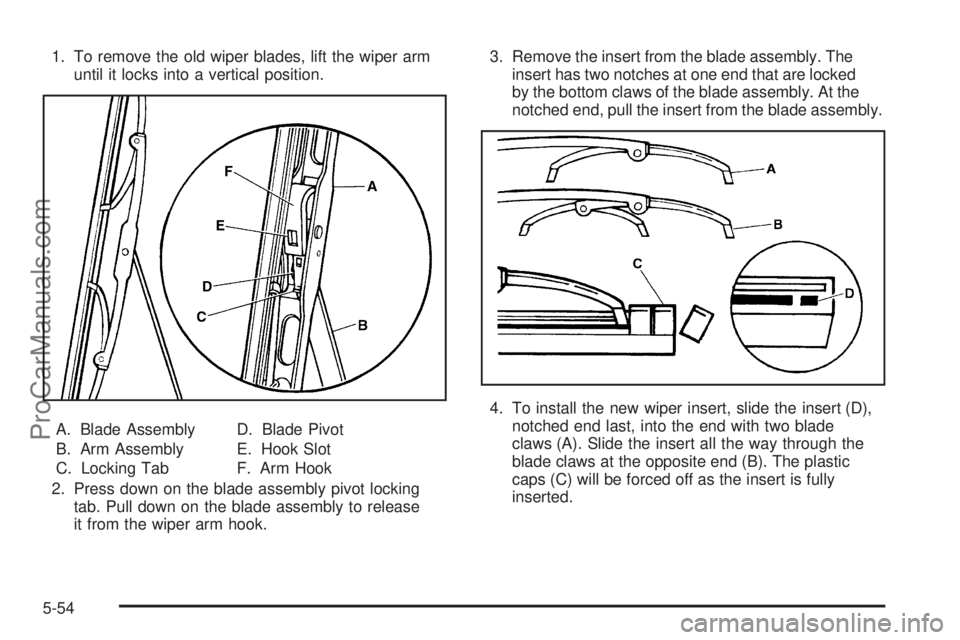
1. To remove the old wiper blades, lift the wiper arm
until it locks into a vertical position.
A. Blade Assembly
B. Arm Assembly
C. Locking TabD. Blade Pivot
E. Hook Slot
F. Arm Hook
2. Press down on the blade assembly pivot locking
tab. Pull down on the blade assembly to release
it from the wiper arm hook.3. Remove the insert from the blade assembly. The
insert has two notches at one end that are locked
by the bottom claws of the blade assembly. At the
notched end, pull the insert from the blade assembly.
4. To install the new wiper insert, slide the insert (D),
notched end last, into the end with two blade
claws (A). Slide the insert all the way through the
blade claws at the opposite end (B). The plastic
caps (C) will be forced off as the insert is fully
inserted.
5-54
ProCarManuals.com
Page 337 of 434
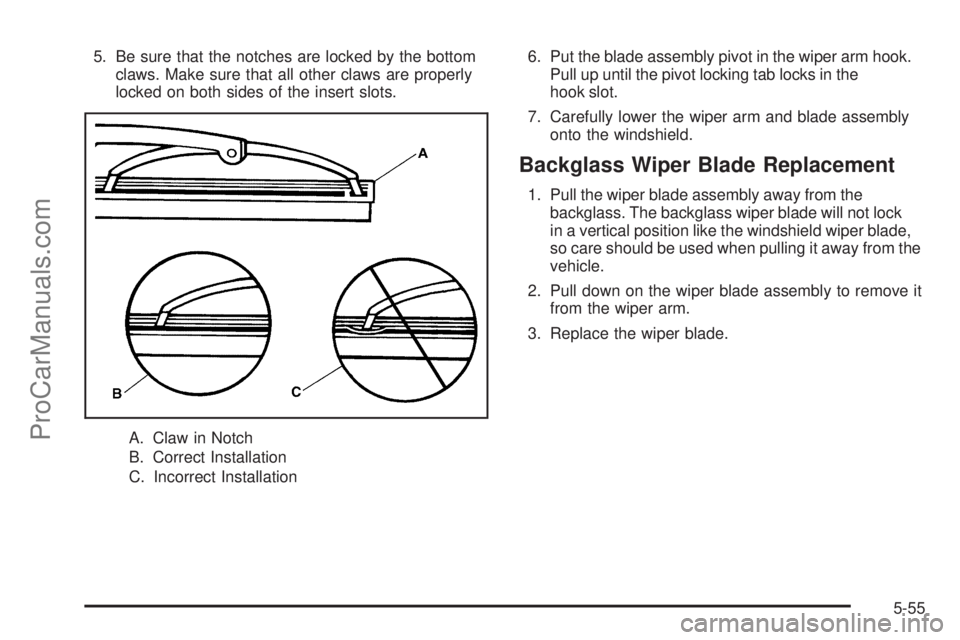
5. Be sure that the notches are locked by the bottom
claws. Make sure that all other claws are properly
locked on both sides of the insert slots.
A. Claw in Notch
B. Correct Installation
C. Incorrect Installation6. Put the blade assembly pivot in the wiper arm hook.
Pull up until the pivot locking tab locks in the
hook slot.
7. Carefully lower the wiper arm and blade assembly
onto the windshield.
Backglass Wiper Blade Replacement
1. Pull the wiper blade assembly away from the
backglass. The backglass wiper blade will not lock
in a vertical position like the windshield wiper blade,
so care should be used when pulling it away from the
vehicle.
2. Pull down on the wiper blade assembly to remove it
from the wiper arm.
3. Replace the wiper blade.
5-55
ProCarManuals.com
Page 338 of 434
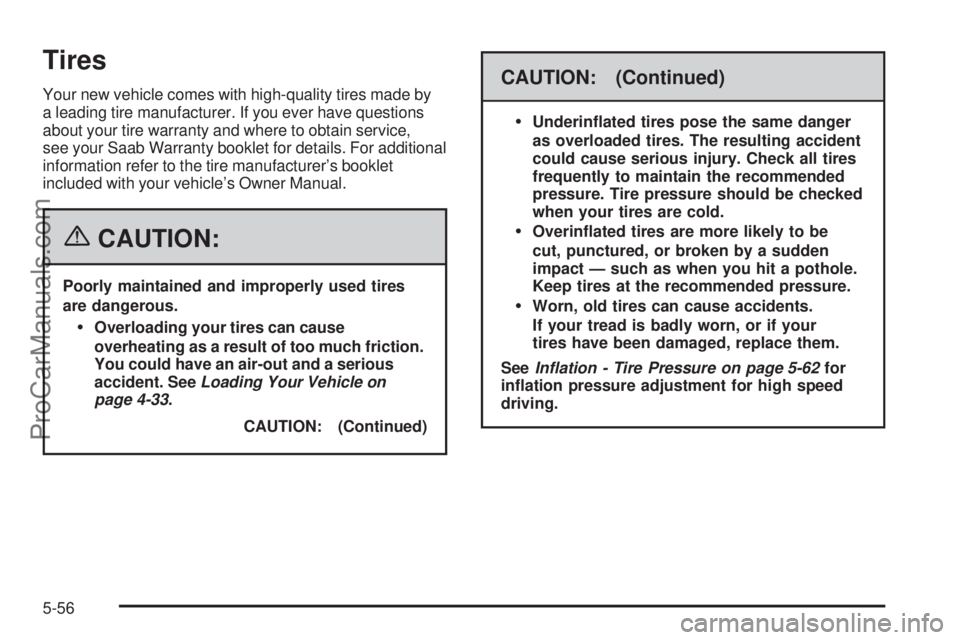
Tires
Your new vehicle comes with high-quality tires made by
a leading tire manufacturer. If you ever have questions
about your tire warranty and where to obtain service,
see your Saab Warranty booklet for details. For additional
information refer to the tire manufacturer’s booklet
included with your vehicle’s Owner Manual.
{CAUTION:
Poorly maintained and improperly used tires
are dangerous.
Overloading your tires can cause
overheating as a result of too much friction.
You could have an air-out and a serious
accident. SeeLoading Your Vehicle on
page 4-33.
CAUTION: (Continued)
CAUTION: (Continued)
Underin�ated tires pose the same danger
as overloaded tires. The resulting accident
could cause serious injury. Check all tires
frequently to maintain the recommended
pressure. Tire pressure should be checked
when your tires are cold.
Overin�ated tires are more likely to be
cut, punctured, or broken by a sudden
impact — such as when you hit a pothole.
Keep tires at the recommended pressure.
Worn, old tires can cause accidents.
If your tread is badly worn, or if your
tires have been damaged, replace them.
SeeInflation - Tire Pressure on page 5-62for
in�ation pressure adjustment for high speed
driving.
5-56
ProCarManuals.com
Page 339 of 434
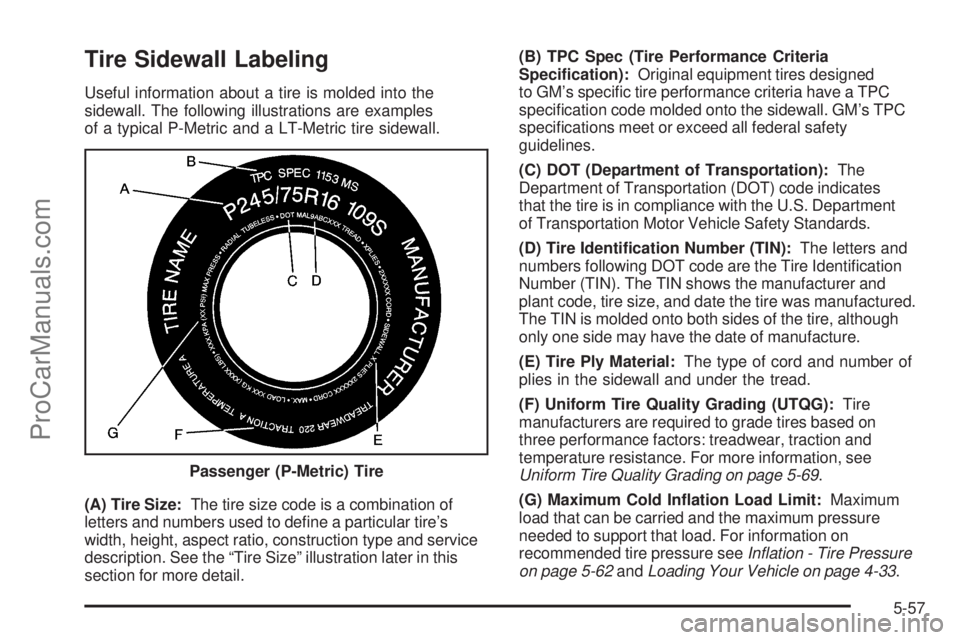
Tire Sidewall Labeling
Useful information about a tire is molded into the
sidewall. The following illustrations are examples
of a typical P-Metric and a LT-Metric tire sidewall.
(A) Tire Size:The tire size code is a combination of
letters and numbers used to de�ne a particular tire’s
width, height, aspect ratio, construction type and service
description. See the “Tire Size” illustration later in this
section for more detail.(B) TPC Spec (Tire Performance Criteria
Speci�cation):Original equipment tires designed
to GM’s speci�c tire performance criteria have a TPC
speci�cation code molded onto the sidewall. GM’s TPC
speci�cations meet or exceed all federal safety
guidelines.
(C) DOT (Department of Transportation):The
Department of Transportation (DOT) code indicates
that the tire is in compliance with the U.S. Department
of Transportation Motor Vehicle Safety Standards.
(D) Tire Identi�cation Number (TIN):The letters and
numbers following DOT code are the Tire Identi�cation
Number (TIN). The TIN shows the manufacturer and
plant code, tire size, and date the tire was manufactured.
The TIN is molded onto both sides of the tire, although
only one side may have the date of manufacture.
(E) Tire Ply Material:The type of cord and number of
plies in the sidewall and under the tread.
(F) Uniform Tire Quality Grading (UTQG):Tire
manufacturers are required to grade tires based on
three performance factors: treadwear, traction and
temperature resistance. For more information, see
Uniform Tire Quality Grading on page 5-69.
(G) Maximum Cold In�ation Load Limit:Maximum
load that can be carried and the maximum pressure
needed to support that load. For information on
recommended tire pressure seeIn�ation - Tire Pressure
on page 5-62andLoading Your Vehicle on page 4-33. Passenger (P-Metric) Tire
5-57
ProCarManuals.com
Page 340 of 434
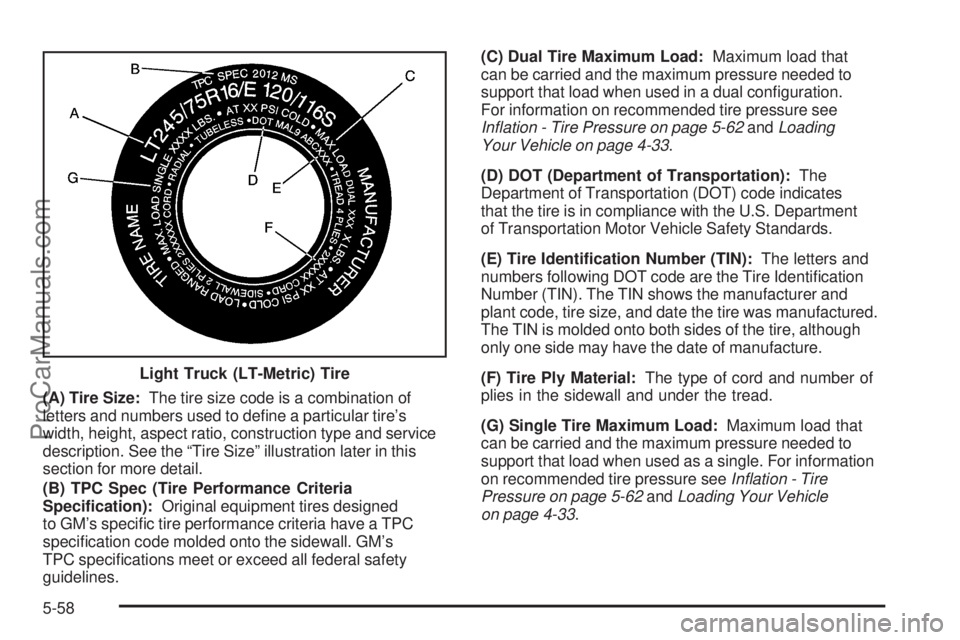
(A) Tire Size:The tire size code is a combination of
letters and numbers used to de�ne a particular tire’s
width, height, aspect ratio, construction type and service
description. See the “Tire Size” illustration later in this
section for more detail.
(B) TPC Spec (Tire Performance Criteria
Speci�cation):Original equipment tires designed
to GM’s speci�c tire performance criteria have a TPC
speci�cation code molded onto the sidewall. GM’s
TPC speci�cations meet or exceed all federal safety
guidelines.(C) Dual Tire Maximum Load:Maximum load that
can be carried and the maximum pressure needed to
support that load when used in a dual con�guration.
For information on recommended tire pressure see
In�ation - Tire Pressure on page 5-62andLoading
Your Vehicle on page 4-33.
(D) DOT (Department of Transportation):The
Department of Transportation (DOT) code indicates
that the tire is in compliance with the U.S. Department
of Transportation Motor Vehicle Safety Standards.
(E) Tire Identi�cation Number (TIN):The letters and
numbers following DOT code are the Tire Identi�cation
Number (TIN). The TIN shows the manufacturer and
plant code, tire size, and date the tire was manufactured.
The TIN is molded onto both sides of the tire, although
only one side may have the date of manufacture.
(F) Tire Ply Material:The type of cord and number of
plies in the sidewall and under the tread.
(G) Single Tire Maximum Load:Maximum load that
can be carried and the maximum pressure needed to
support that load when used as a single. For information
on recommended tire pressure seeIn�ation - Tire
Pressure on page 5-62andLoading Your Vehicle
on page 4-33. Light Truck (LT-Metric) Tire
5-58
ProCarManuals.com